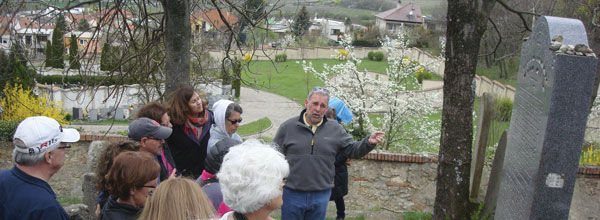Right tour—wrong name
Published May 11, 2016
The title at the top of the itinerary read, “Jewish Heritage Tour to Eastern Europe.” Departing St. Louis at the end of March, 15 Congregation Shaare Emeth congregants were joined by five others, friends and family, who live in other cities. Over the next two weeks, each traveler would be touched at a deep personal level by the intense immersion.
My wife, Ann, and I have had Eastern Europe on our bucket list for some time, and this trip, during which we visited Berlin, Prague, Budapest, Krakow, Warsaw and points in between, was a great way to “Czech” it off. Rabbi Jim and Amy Bennett organized and led the tour with skill and grace. The itinerary, the local expert guides, the insights of our Israeli travel agent who was with us throughout the trip, and Bennett’s perspective made for an informative, energizing and delightfully exhausting experience.
All that being said, I came away concluding that the trip was misnamed. We visited the important sites that characterize and emphasize what Eastern European Jewish communities experienced at the hands of the Nazis. And we learned about how these communities, albeit frequently limited by bigotry and restrictive laws, had been reasonably thriving before the Nazi era and about how, in many ways, the communities are reemerging. We toured every corner of Terezinstadt, walked through the ancient Jewish cemetery of Prague, were guided through the Jewish Museum of Budapest, the Schindler Factory in Krakow, and the Warsaw Ghetto site, and attended Shabbat Services and ate dinner with members of Berlin’s Reform congregation.
ADVERTISEMENT
We held a memorial service along the banks of the river for the 22,000 Jews who had died of disease and overwork at Terezin and who had been cremated and desecrated by having their ashes unceremoniously dumped into the waters. In the Jewish Museum in Berlin, we experienced the stark, empty, and deathly silent rooms entitled “Memory Voids,” in which only one has an exhibit, “10,000 Leaves.” More than 10,000 circular and thick iron plates cover the floor—each plate has the cutout of a face crying out silently for help. We stood in front of the walls of a former synagogue in Prague on which the hand-printed names of over 85,000 murdered Czech Jews were listed. Our guide in Budapest was a Holocaust survivor who, when she was 6, was about to be shot, but was saved by her non-Jewish nanny. We trudged through Auschwitz-Birkenau on a drizzly, dreary day—enough said.
“Jewish Heritage?” The dictionary definition of “heritage” is “something that comes or belongs to one by reason of birth; an inherited lot or portion.” So, yes, the word technically applies to our trip, but it seems to grossly understate and soften what we learned and saw.
“Jewish Heritage?” Yes, technically, it is our heritage, but similarly, use of the word “Jewish” seems to grossly understate the circumstances. What transpired was inflicted “on” the Jews, not “by” us. “Jewish Heritage” is a term of separation, as if we, the Jews, solely and soulfully own it.
ADVERTISEMENT
Humanity, as a whole, owns what happened, in the same way we all own what is happening around the world today. In our hotel rooms across Eastern Europe, we saw the banners of news highlights scroll across the bottom of CNN and BBC screens. Weary and vulnerable Syrian refugees being deported from Greece back to Turkey. Battles between Armenia and Azerbaijan intensifying. American politicians speaking of building walls, juxtaposed on our visits to the walls of the ghettos, the walls of the concentration camps, and the Berlin Wall. Arrests of more perpetrators of the Brussels bombings yet not mitigating that the atrocity still happened. The U.N. estimates that 300,000 people have been killed in fighting in Darfur to date. And on and on.
We can honor the Jews and many others who were murdered by the Nazis while still appreciating that we “survived.” We can celebrate, for now, that we are fortunate to worship and live freely in the United States. We can recognize that Eastern European Jewish communities are reemerging. We can thank the governments and people of Eastern Europe, including and perhaps most significantly, the Germans, who are openly acknowledging their role in what happened during the Nazi era, memorializing the events, and proactively working to never let it happen again.
But don’t we also know that human history promises otherwise? As but one example in a small corner of the world—we learned enough of Czech history to be reminded of how we tend to treat each other. The Czechs once ruled the Germans. For hundreds of years after that, the Czechs lived under the thumb of other countries and empires. In August 1968, a Charles University student in Prague set himself on fire to protest the Soviet invasion of his country. Having nothing to do with the Jews, those seeking more power have historically left common people subjugated, persecuted, oppressed, and dead. Since the fall of communism, the Czechs are free; but for how long?
So, the right trip? Definitely. Thank you, Rabbi Jim and Amy Bennett. Thank you to our fellow travelers for your comradeship. Thank you to the Eastern European congregations who welcomed us. Thank you to my sisters, Marti (Ferdman) and Carol (Strelic) for being on the trip with us and making it so special in that regard. Right trip!
But, the right name? No. From now on, I will not think about the Holocaust or the Nazi era as “Jewish Heritage.” Too understated. Too soft. Too much isolating it as only our “inherited lot or portion.” Wrong name!















